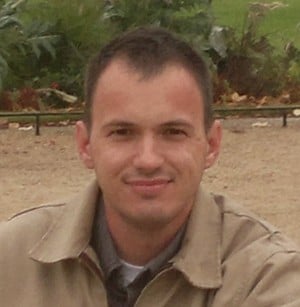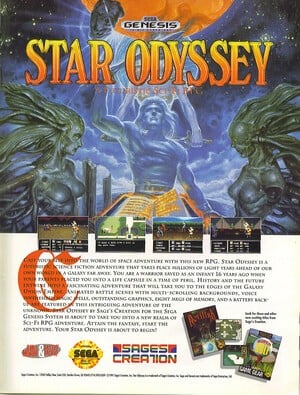
If you're the kind of person that appreciates vintage gaming then chances are you're already familiar with Super Fighter Team.
Formed in San Diego, California with the express intention of giving long-forgotten games a new lease of commercial life, the group has already successfully localised and published a series of titles, including Beggar Prince and Legend of Wukong — the first games to be commercially released on the Sega Mega Drive/Genesis in the US since 1998.
Now the team has brought another RPG back from the dead. Star Odyssey was released in Japan under the title Blue Almanac way back in 1991, and this launch marks the first time it has ever been published in the West. We caught up with Super Fighter Team president Brandon Cobb and asked him a few questions about this exciting retro game development.

Nintendo Life: What made you select Blue Almanac as your next project?
Brandon Cobb: By sheer chance, while discussing unreleased games with collector Jason Wilson, I was presented with the opportunity to acquire the only known, English language prototype of Blue Almanac. As we were still working on Legend of Wukong at the time, I was only able to do a quick play-through of the game in order to get a first impression. What I saw was more than enough to convince me that it would make for a great new release.
NL: Is it true that game was close to a US release back in the early '90s? Why didn't this take place?
BC: Not only was it close to a release, but was in fact advertised in several magazines. Remembering one of these ads from my childhood was the catalyst that pushed me to contact Starfish-SD to negotiate a license: we were promised Star Odyssey back then, and I wanted to make sure that promise came to fruition, regardless of how much time had passed.

As for why the game wasn't released in the '90s, well we found a critical bug in its code that caused the game to crash after being played for several consecutive hours. The bug, which was difficult to isolate and repair, may have proven too difficult or too time consuming for the original localisation team to handle. Or, perhaps the intended publishers simply felt the American market wasn't ready for another import RPG just yet — after all, Japanese RPGs were initially slow to make waves here in the USA.
NL: How much work had been done on the US version before it was abandoned?
BC: The initial work was definitely performed on a prototype version of what would become the Japanese release, as illustrated by the fact that several important elements had not yet been added: the intermission cut scenes, for example, and the neat palette effect that appears during the appearance of the title screen. The script, while translated into English, didn't make a lick of sense, and there were several bits of unused text and a couple of unused features.
In addition to fixing bugs (some of which had even appeared in the commercially released version of Blue Almanac in Japan), we adapted in the missing features and even added a few new ones.

NL: Was it difficult obtaining the rights to publish the game in the West?
BC: On the contrary; Starfish-SD was eager to work with us from the start, providing a quick and comfortable experience. Once the contract was signed, their marketing director was kind enough to give us a "salute" for our "passion to develop an exciting game."
NL: How long did it take to completely localise the game?
BC: Our team's skills are greatly honed by now, and we have a firm understanding of both the work and each others' needs. The localisation process therefore only took around six months to complete, followed by about another six months for bug fixes, enhancements and general polishing of the product.

NL: What were the biggest stumbling blocks you encountered during the process?
BC: Apart from the game crashing bug which I already mentioned, there weren't any real stumbling blocks to speak of. Some of the other bugs we corrected seemed to have been simple oversights on the part of the Japanese developers; things only really noticed by the eyes of a perfectionist. Even so, we find it important to give our all in every aspect of the reprogramming process. In other words, the little things count for a lot.
NL: Can you tell us how you've improved on the original Japanese edition?
BC: In addition to what's already been shared, we also balanced the difficulty out a bit towards the end of the game, and connected the previously dormant character death screams to the combat engine.

NL: Once this print run sells out, do you have plans to make any more copies?
BC: It has already sold out and yes, we have arranged for additional copies to be produced in order to meet continued demand. Therefore the game remains available for ordering.
NL: What has the community feedback been like towards the project?
BC: The first batch, consisting of 300 copies, sold out in just six days. That sort of occurrence is completely unheard of in this niche market, which speaks volumes about how highly anticipated this release was. We are quite proud of this result, and very grateful to our fans for making it possible.
NL: With services like the Nintendo Virtual Console already playing host to classic games, have you considered making titles like Star Odyssey available for download?

BC: Call me crazy, but I feel that Genesis games are meant to be played... on a Genesis.
NL: Do you have any more projects in the pipeline that you can tell us about?
BC: We'll soon be releasing a new and improved version of Sango Fighter 2 for the PC, as a free download. Previously available as a commercial product, and then only in Chinese or Korean, we acquired full ownership of the title in 2009. A proper English version of the game has been a request of many PC gamers for years. I hope they will enjoy what we have in store for them.
* Star Odyssey is available for order direct from the Super Fighter Team website.*





Comments 9
"With services like the Nintendo Virtual Console already playing host to classic games, have you considered making titles like Star Odyssey available for download?"
"Call me crazy, but I feel that Genesis games are meant to be played... on a Genesis."
Super Fighter Team is crazy. Why would you even bother working so hard to release these games if you're only planning to cater to the hardcore gaming enthusiasts?
Virtual Console is there, you probably don't need to do much besides uploading the ROM anyways. Use it to bring your games to the masses and then use that added revenue to fund future projects. Enthusiasts will still buy physical copies because that's what gaming enthusiasts do.
I would like to see this on the VC, despite his feelings towards physical media. Still, this company's work intrigues me. I'll be keeping an eye on them for sure.
Quite an interesting interview.
Before reading the section mentioned by sykotek i thought my comment would be "So when's it coming to the VC ?".
While i can understand that they are doing all this for authenticity i guess i'll never get a Genesis.
And it may be that they don't want to devaluate their product. $40.00 (excluding s+h) compared with $8.00 for a Genesis VC game makes a huge difference to me. And i wouldn't be willing to pay that much more for a cartridge, instruction manual and a plastic shell for such a game. without real nostalgia going on for it
Also I don't know if Nintendo would allow an unreleased game to launch on VC, and the team's licensing agreement may not cover it. Still really interesting stuff, though!
"Call me crazy, but I feel that Genesis games are meant to be played... on a Genesis."
Yeah, I don't have one, can you pay you money to download it somehow? PC emulator, VC, I dunno. I really like the way this game looks and feature some of the biggest sprites in an RPG battle scene I've ever seen.
Personally speaking, I recall seeing an news item for Blue Almanac in Mean Machines magazine and thinking it looked really great. I never knew it was so close to being released in the West back in the early '90s, so I'm really keen to play this edition. It's just mind-blowing that someone is bringing these lost games to life again, and I'm really happy that the companies involved have been so accommodating.
This is neat:) I'm definitely a fan of "dead" consoles still going via efforts like this. Heck, I always thought it would be cool if, say, students were allowed to publish games for last gen-consoles. Like say releasing budget, retail PS2 games NOWADAYS. Sony could just "unlock" the thing, stop policing the platform, and give anyone the means to manufacture a retail game. It would be great for people learning to put games together, and also be great for the platforms to keep going. It's going to happen anyway, but it would be nice for these groups of hackers, hobbyists and rookie game-makers to have a more "legal" way to pull this trick off. Instead of the rare example, like the team here, or that guy who manufactured Battle Kid for NES last year.
hey, i remember that ad ! i wondered what was this game until i forgot about it... now it seems to be back !
too bad i dont own a genesis bring those forgotten titles to the virtual console !
simply do both physical and vistual. feed off the easy money from the virtual market to make those physical things.
I've heared of these guys. I think it's pretty awesome how devoted they are to releasing these old games.
Tap here to load 9 comments
Leave A Comment
Hold on there, you need to login to post a comment...